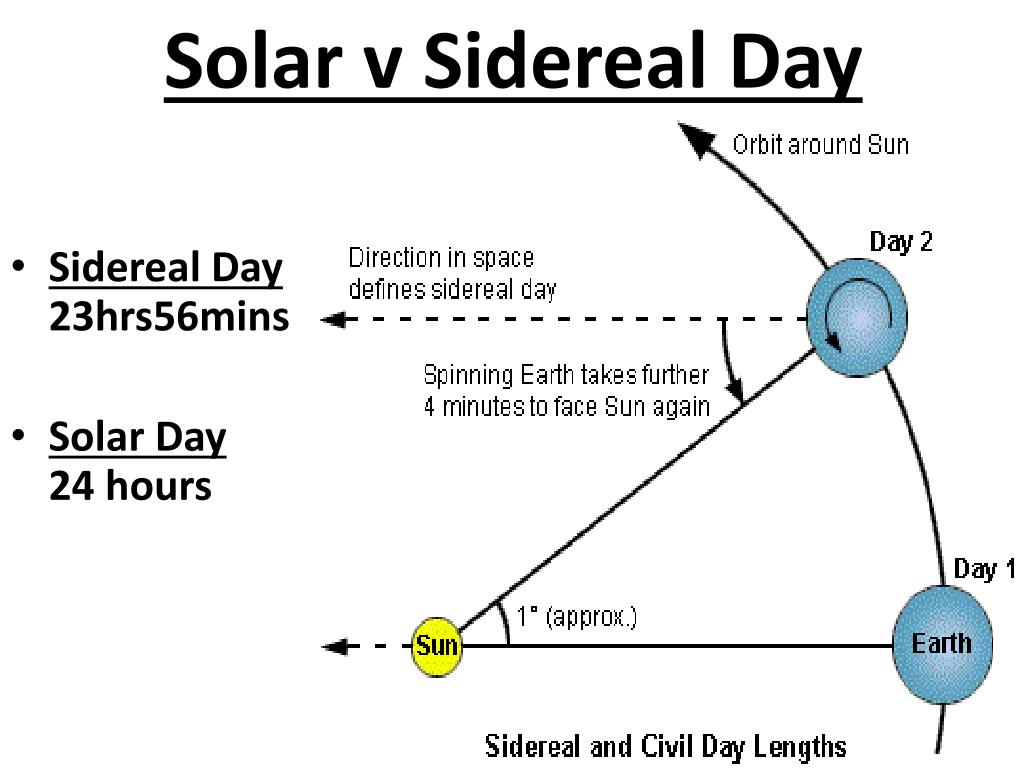The unforgettable Dinah Washington recorded a song titled What A Difference A Day Makes … “♪ 24 hours ♪”. A scientist may ask, “What kind of day?”
The day with which everyone is familiar is a solar day, a 24-hour clock-time day. Astronomers, satellite operators, and precision navigation systems engineers know about the sidereal day. What is the chief difference? The solar day is apparent time; the sidereal day, also known as astronomical time, is the actual time for one rotation of the earth. The apparent solar day never changes. The sidereal day is slightly less than a solar day, and it changes. The difference between apparent and actual time is the reason we have a leap year every four years.
Dinah Washington, or you, may ask, “How can a sidereal day change?” It changes because the rotational speed of the earth is not constant. It sometimes speeds up and sometimes slows down, but when averaged over long intervals, the trend indicates that it is gradually slowing, according to the National Institute of Standards and Technology (NIST).
Studies of ancient crustaceans, specifically mollusks, reveal shorter days in Earth’s history. What affects the Earth’s rotational speed?

Consider physical phenomena you have experienced over your lifetime. If you ever carried a big bucket of water while walking, you will remember the sloshing that accompanied the pull of the bucket, contrary to the direction of your movement. On a grander scale, this sloshing phenomenon occurs in our ocean basins.
People who live along coastal saltwater are familiar with twice-a-day high tides. It is the enormous gravitational force between the rotating earth and the moon. Now, imagine buckets of water, the ocean basins containing 326 million trillion gallons of water, according to NASA. Awesome! Right?
Deep within the earth, 400 miles below the surface, is an aquifer that encircles the earth and holds three times the water of all the oceans on the surface of the earth: 978 million trillion gallons of water!
The moon, on average, moves away from the Earth at approximately 1.49 (3.78 centimeters) inches per year. Over 6,000 years, the distance between the Earth and the moon has increased approximately 745 feet.
As a child, you may have swung about you a bucket of water on a length of rope. If you shorten the rope length, you can spin about more quickly. As you lengthen the rope, you will slow down. Why? The force available in your physical body is finite. Lengthening the rope taxes your physical strenth and the bucket will spin about you more slowly with added length of rope.
Translate the above bucket-of-water analogy to the effect of the distance between the Earth and the moon. The masses of both bodies are constant. As the distance between the two bodies increases, the Earth will naturally slow down its rotational speed.

Imagine what would happen to the chicken roasting on a rotisserie if you slow down the rotational speed. What would happen if you stopped the rotation altogether?
Would not the chicken cook hotter at a slower rotisserie speed? Consider a story from Live Science magazine.
“From lakes and grasslands with hippos and giraffes to a vast desert, North Africa’s sudden geographical transformation 5,000 years ago was one of the planet’s most dramatic climate shifts.“
Isn’t science fun? Is your imagination stirred up?

John White
Rockwall, Texas

